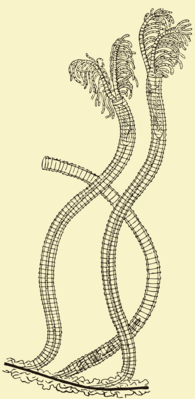Wing gill
| Wing gill | ||||||||||||
|---|---|---|---|---|---|---|---|---|---|---|---|---|

Rhabdopleura normani |
||||||||||||
| Systematics | ||||||||||||
|
||||||||||||
| Scientific name | ||||||||||||
| Pterobranchia | ||||||||||||
| Lankester , 1877 |
The wing gills (Pterobranchia) are marine hemichordata . The millimeter-sized worm-shaped animals mostly live colonial on the sea floor, where they filter food particles out of the water with their characteristic tentacle apparatus. They were originally only known from dredge samples from the deep sea , but have now also been detected in shallow water in warm seas.
Characteristics and kinship hypotheses
The body of the wing gill can be subdivided into the tentacle region serving to catch food, the housing-building rostral shield and the sac-shaped trunk containing intestines and gonads . Coelom spaces exist only in the rostral shield and in the tentacle region. The body of most species is dark in color, the tentacles reddish. There is a red band at the bottom on the front of the rostral shield .
Due to the tentacle apparatus, possible close relatives of the Lophophorata (syn .: Tentaculata), a large group of horseshoe worms ( Phoronida ), arm pods ( Brachiopoda ) and bryozoa ( bryozoa ) were also seen in the wing gills . This kinship hypothesis was of great importance for the system of bilaterally symmetrical animals ( Bilateria ) because it brought together the wing gills as supposedly primeval deuterostomians with the Lophophorata as supposedly primitive protostomies . In some of these interpretations they were even seen as representatives of the most primitive Bilaterians.
Molecular biological studies have not been able to confirm such a primal status of the wing gills, so that it is now assumed that their filtering apparatus is not homologous to the filtering apparatus of the Lophophorata, and that there is no other closer relationship to protostomes.
According to these studies, the wing gills are more of a very specialized deuterostomy group, which most likely arose from acorn worm-like precursors (earlier it was assumed for the hemichordata rather the reverse evolutionary process , i.e. acorn worms emerged from wing gill-like precursors).
On the basis of deep-sea photos from the 1970s, intermediate forms between wing gills and acorn worms, so-called "Lophenteropneusten", were identified in 2005 after the first catches of these animals as specialized acorn worms that can only be very hypothetically associated with wing gills. The animals, some species of which have now been found, have been described as the new Acorn worm family Torquaratoridae . Despite numerous differences to the wing gills, they are remarkable in that at least some species have been shown to live, analogous to the wing gills, in self-isolated residential tunnels.
Internal system
There are currently two orders with two families . The families are differentiated on the basis of the tentacle apparatus, the building structure and other anatomical features.
- Order Cephalodiscoidea
- Family Cephalodiscidae , four to nine pairs of tentacles with up to 50 feathers per tentacle.
- Genus Atubaria Sato, 1936 ( nomen dubium )
- Genus Cephalodiscus
- Genus Pterobranchites Kozlowski, 1967 , only preserved in fossil form
- Family Eocephalodiscidae Kozlowski, 1949 , only preserved in fossil form
- Family Cephalodiscidae , four to nine pairs of tentacles with up to 50 feathers per tentacle.
- Order Rhabdopleuroidea
- Genus Diplohydra Kozlowski, 1949 , only preserved in fossil form
- Genus Graptovermis Kozlowski, 1949 , only preserved in fossil form
- Family Rhabdopleuridae
- Genus Eorhabdopleura Kozlowski, 1970 , only preserved in fossil form
- Genus Fasciculitubus Obut & Sobolevskaya, 1967 , only preserved in fossil form
- Genus Kystodendron Kozlowski, 1959 , only preserved in fossil form
- Genus Rhabdopleura , only one pair of tentacles with up to 15 to 30 feathers per tentacle.
- Genus Rhabdotubus Bengtson & Urbanek, 1986 , only preserved in fossil form
- Family Rhabdopleuritidae Mierzejewski, 1986 , only preserved in fossil form
- Family Rhabdopleuroididae Mierzejewski, 1986 , only preserved in fossil form
- Family Stolonodendridae Bulman, 1955 , only preserved in fossil form
Close relatives of the wing gills are the extinct graptolites , which were distributed worldwide from the Middle Cambrian to the Lower Carboniferous and are important key fossils for the Ordovician and the Silurian . In addition to sessile forms, many genera are known of them that lived pelagically with the help of floating bodies . The fossilized parts of the wing gill Cephalodiscus graptolithoides are so similar to the fossils of the graptolites that some scientists are of the opinion that the graptolites must be classified in the pterobranches.
literature
- Wilfried Westheide & Reinhard Rieger: Special Zoology Part 1: Protozoa and Invertebrates , 2nd Edition, Spectrum Academic Publishing House Heidelberg • Berlin, 2007, ISBN 3-8274-1575-6
Individual evidence
- ↑ KM Halanych: Convergence in the feeding apparatuses of lophophorates and pterobranch hemichordates revealed by 18S rDNA: an interpretation . In: Biological Bulletin 1996, No. 190, pp. 1-5
- ^ ND Holland et al .: Lophenteropneust hypothesis refuted by collection and photos of new deep-sea hemichordates. In: Nature 2005, No. 434, pp. 374-376
- ↑ Kenneth M. Halanych, Johanna T. Cannon, Andrew R. Mahon, Billie J. Swalla, Craig R. Smith (2013): Modern Antarctic acorn worms form tubes. Nature Communications 4: 2738 doi : 10.1038 / ncomms3738
- ^ Hynek Burda , Gero Hilken, Jan Zrzavý: Systematic Zoology. UTB, Stuttgart; : 1st edition 2008, page 225, ISBN 3-8252-3119-4
Web links
- van der Land, J. (2010). Pterobranchia: World Register of Marine Species Pterobranchia